Therapy dogs lend a helping paw
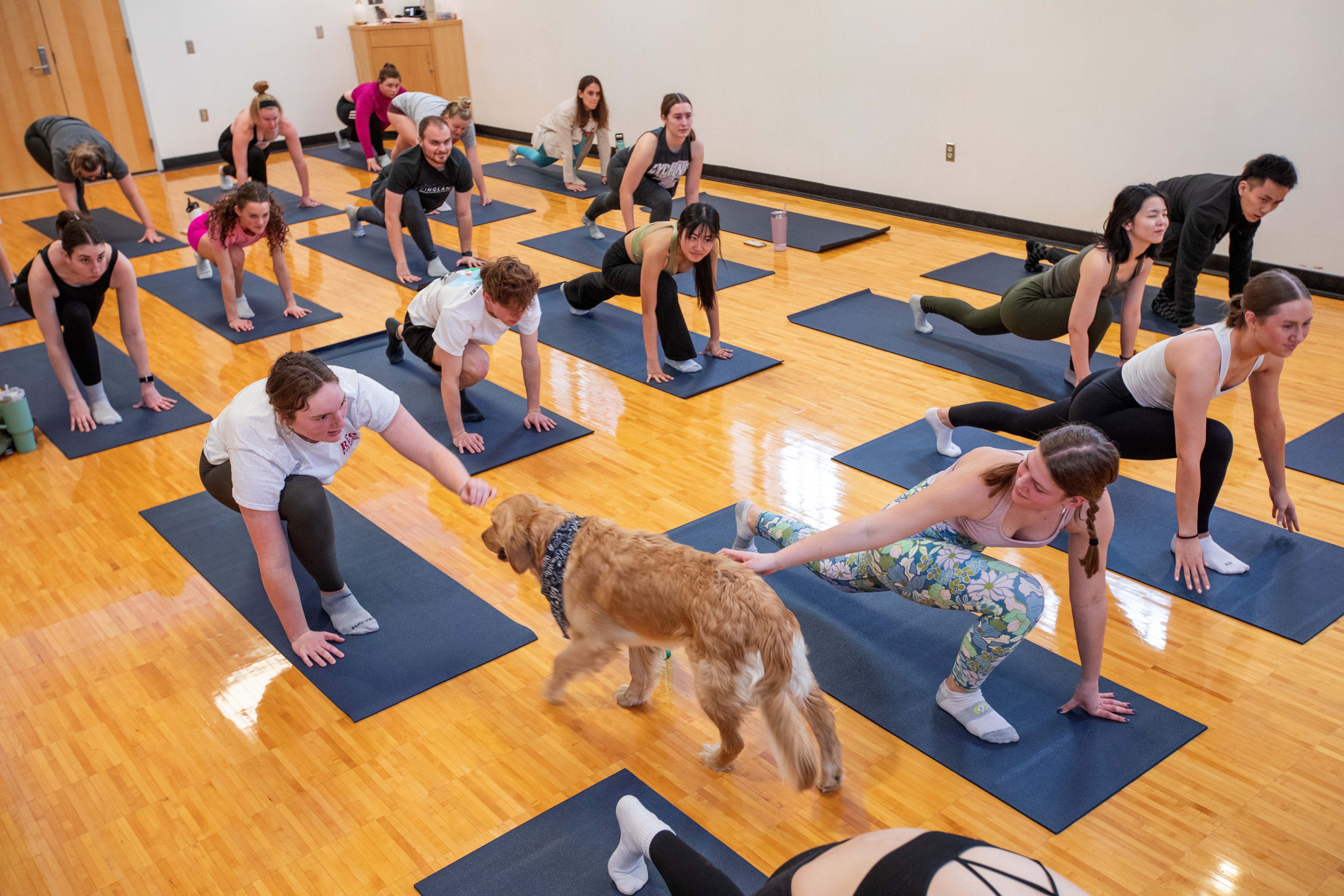
Yoga class participants reach out to greet Sydni, a 1-year-old golden retriever therapy dog, during a visit to a yoga class in State Gym Wednesday afternoon. Photos by Christopher Gannon.
Four years ago, Zosia joined the ISU police department as a certified therapy dog, but it didn't take long to realize the dog's responsibilities were going to outgrow her business card in a hurry. Yes, Zosia has a card with her email address and a schedule that keeps her paws on campus pavement most days.
Request
To schedule the therapy dogs to come to a department or unit, use the ISU Safe app or email isupdmh@iastate.edu. Hauser asks for a couple weeks' notice, when possible.
"When we started, I really thought it would be about dealing with crisis calls and going out when someone is in crisis," mental health advocate supervisor Kinsey Hauser said. "Almost immediately it turned into so much more, which is fun to see."
Zosia, who celebrated her 12th birthday this week, is one of three golden retriever therapy dogs with the department. Hauser owns Zosia and 1-year-old Sydni, who is in the process of becoming a certified therapy dog. Zeb, Zosia's grandson owned by Hauser's brother, also helps on campus. The dogs assist at freshman orientation, visit staff at Mary Greeley Medical Center, go to classes on campus to help conduct mental health presentations and are often available to students when they seek out the police department for resources.
"The dogs are a good way to get people into the office, and when we tell them that there are dogs available to them, we typically find that people are more open to that," Hauser said.
Hauser and mental health advocate April Ranck speak to students, faculty and staff on mental health and well-being, identifying signs and symptoms of mental illnesses and conduct a mental health first aid course.
Hauser always is looking for ways to increase the dogs' impact by interacting with students, faculty and staff walking on campus. The dogs also take part in Barks at Parks -- the activity during prep week each semester when community members bring their dogs to Parks Library to help students relax -- but their responsibilities go much further. This week, Zosia and Sydni took part in their first dog yoga special session at recreation services to help students de-stress ahead of the midterm. On March 31 (10-11 a.m.), the dogs will be at Curtiss Hall for "Woofs and Wellness" to hand out resource cards and stuffed replicas of Zosia.
Meeting time
With the launch of the ISU Safe app in February, requesting the therapy dogs is just a click away. Users can send an email by clicking on "Therapy Dogs" under the ISU police menu. Hauser said requests have begun to come in. Departments and units also can request the dogs for a meeting to de-stress or to learn more about mental health options.
"Anyone affiliated with Iowa State can request the dogs," Hauser said. "The weekly meetings that departments have is a great time to have us in and provides a nice break with the dogs. People's faces just light up when they see the dogs."
And don't expect the birthday girl to slow down anytime soon.
"Zosia gets really mad when I don't take her to work," Hauser said. "She will stand at the back door and bark at me. She loves coming to work."
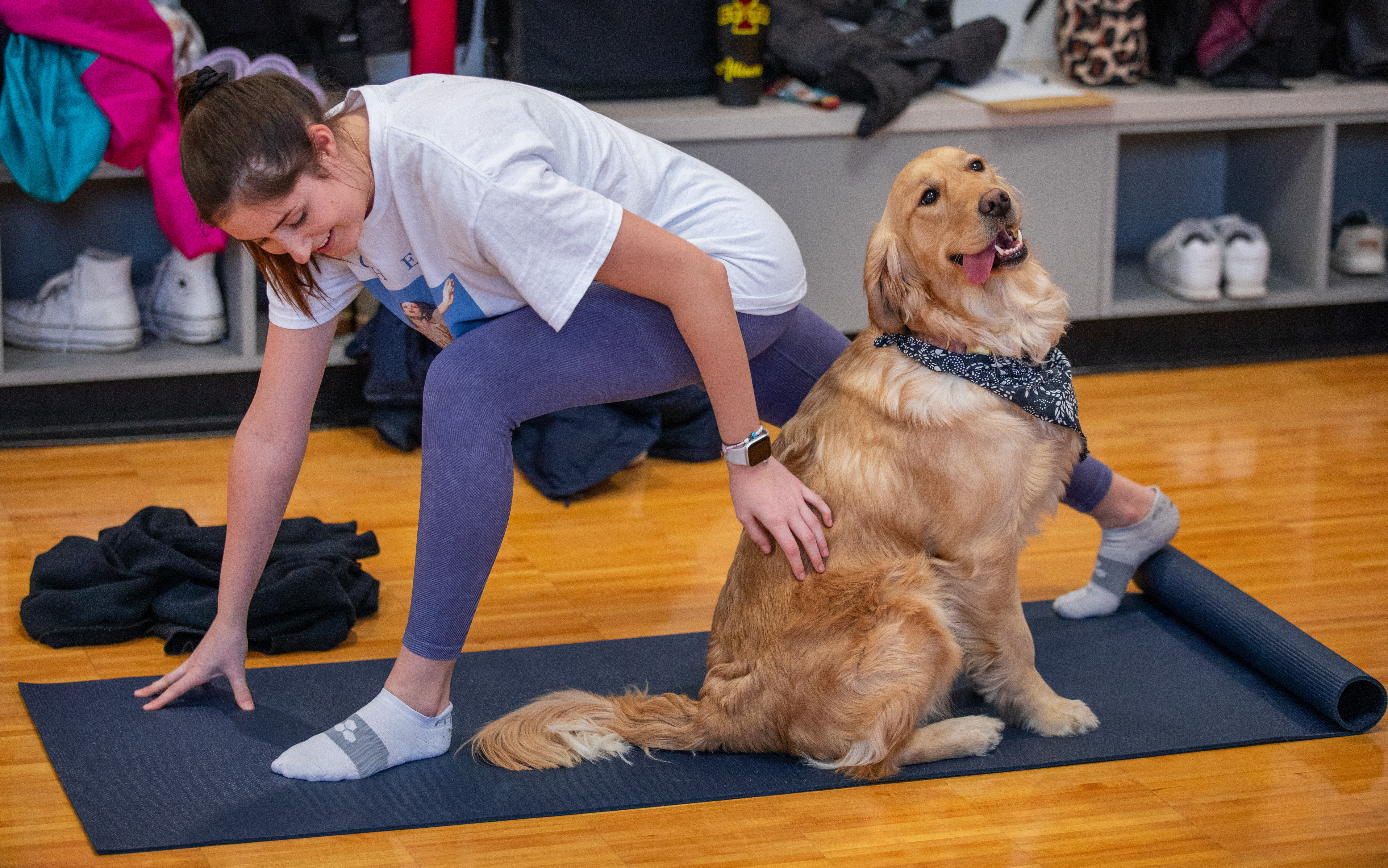
Sydni, a golden retriever therapy dog, joins Audrey McMillan to strike her own pose during a therapy dog visit to a yoga class in State Gym Wednesday afternoon.
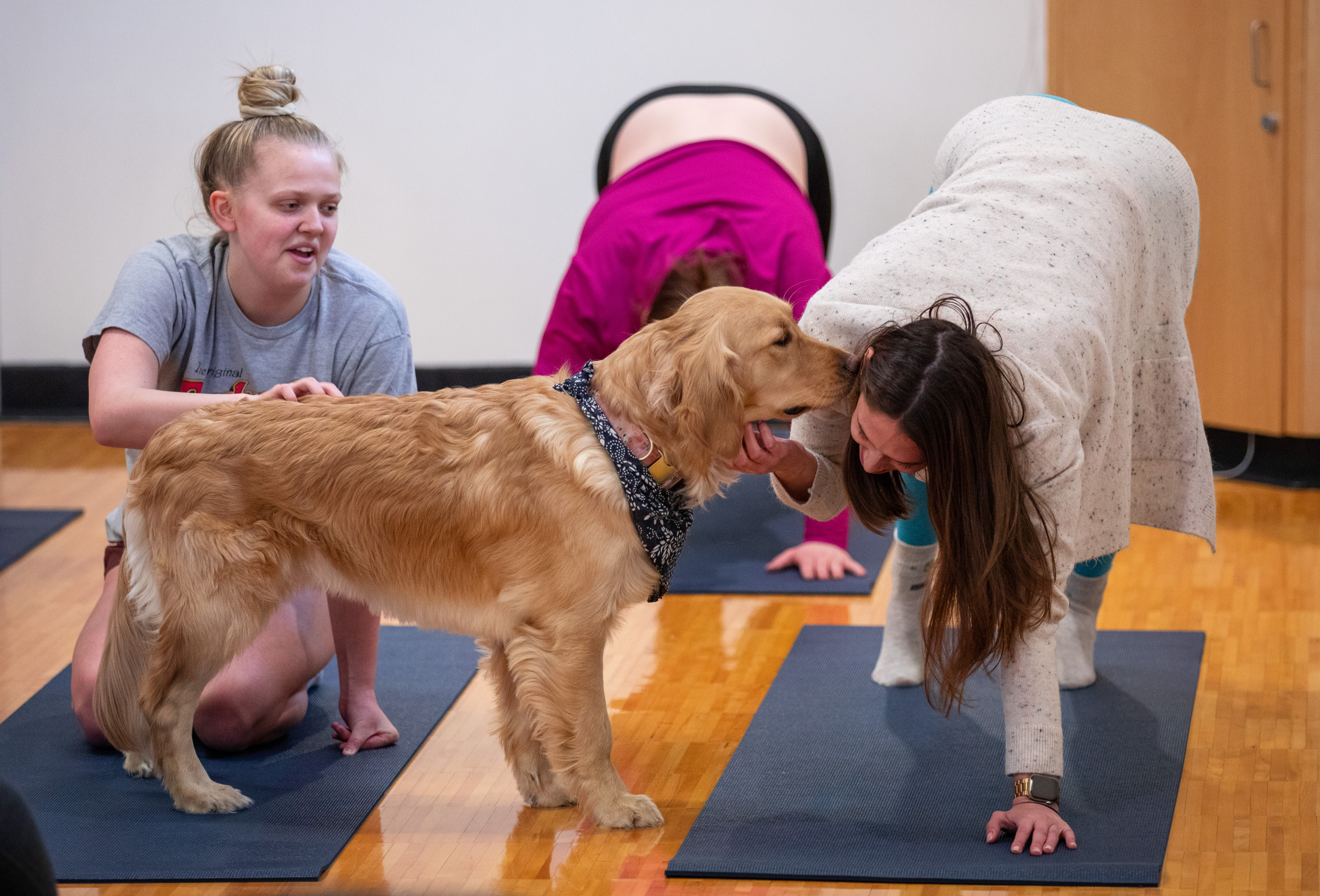
Veronica Armstrong (left) and Regina Castejon are greeted by Sydni during a therapy dog visit to one of recreation services' yoga classes in State Gym.
Proposal process opens for strategic plan funding
The inaugural call for proposals to advance Iowa State's new nine-year strategic plan is open. Faculty and staff are invited to submit proposals by late April for funding consideration.
"We are looking for ideas that align with the strategic plan's statements of aspiration and have the potential to move Iowa State forward in transformational ways," said Sophia Magill, senior advisor to the president.
Proposals should focus on one or more of the five goals that define what Iowa State aspires to become over the next nine years:
- To be the most student-centric leading research university
- To be the university that cultivates a diverse, equitable and inclusive environment where students, faculty and staff flourish
- To be the university that fosters lifelong learning
- To be the university that creates opportunities and forges new frontiers
- To be the trusted partner for proactive and innovative solutions
"This proposal process is an exciting opportunity to engage our faculty and staff in how we bring our strategic plan to life," Magill said. "We welcome proposals of all sizes."
Magill noted that the timeline for this first cycle will be more condensed than future years. To be considered for funding for the fiscal year that begins July 1, proposals must be submitted through the strategic plan website by 5 p.m. April 28. Requestors should be prepared to complete the submission in one sitting; the system doesn't save partial entries. Magill said she anticipates decisions about funded proposals will be shared by the end of June.
Learn more
Magill will hold information sessions during the week following spring break in the Memorial Union Campanile Room. Faculty and staff members interested in applying for strategic plan funds are encouraged to attend a session to learn more about the process and get answers to their questions. The dates and times are:
- Monday, March 20, 3-4 p.m.
- Wednesday, March 22, 9-10 a.m.
- Thursday, March 23, 2-3 p.m.
The strategic plan website has been updated with an FAQ about the proposal process and with selected stories that illustrate progress toward the plan's five to-be statements. Additional questions can be emailed to strategicinitiatives@iastate.edu.
Editor's note: This story was added to the publication on March 10.
Innovative ideas shine in pitch off finale
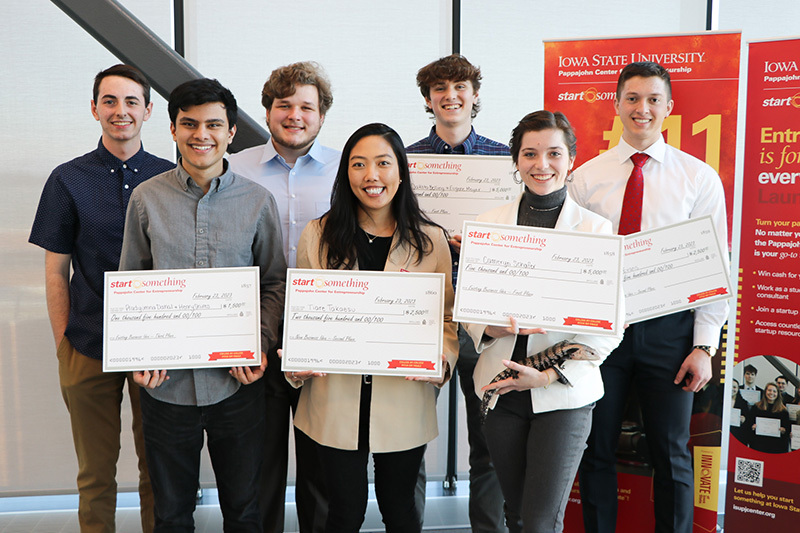
Top-three finishers in the college-by-college pitch off finale. Back (l to r) Henry Shires, Eugene Meyer, Dakota Belling and Jack Evans. Front is Pradyumna Dahal, Tiare Takaesu and Cameryn Schafer. Contributed photo.
Standing a few feet in front of a panel of judges, student after student made their pitch and confidently answered every question. It quickly became apparent who had the toughest job in the pressure-packed environment -- the judges.
College results
See the top finishers from each college in this spring's pitch off competition.
The sixth annual Pappajohn Center for Entrepreneurship college-by-college pitch off wrapped up last week -- after weather delayed it seven days -- with a campuswide finale. Twenty-five student entrepreneurs stated their case in the Student Innovation Center.
The pitch off series begins locally with students competing against fellow classmates in their college for first- and second-place prizes of $500 and $250 in one of two categories: new idea or existing business idea for plans that have already moved past the concept stage. They get 90 seconds to make their pitch, with two minutes allowed for follow-up questions by the judges.
The top two placers from each college competed in the March 2 finale, where the winners in each category took home $5,000. Second-place finishers received $2,500 awards, third took $1,500 and -- announced after all pitches were complete -- five students received $1,000 honorable mention awards. The judges were Ivy College of Business dean and interim vice president for economic development and industry relations David Spalding, Ames Chamber of Commerce and Economic Development Commission director of business development Dylan Kline, ISU Startup Factory director Peter Hong and digital and precision agriculture biobased sciences platform chief technology officer Nadilia Gomez.
The overall winner for best existing business was Cameryn Schafer, a senior in animal ecology, who pitched to the judges holding her blue-tongued skink (lizard). She sells NutriCubes, preportioned servings of blended ingredients for exotic animals.
The best new idea winners were Eugene Meyer and Dakota Belling for developing Bovi-Jet, an insect control applicator for large cattle herds. Belling is a senior in civil engineering and Meyer is a senior industrial engineering major. The duo showed the work students put in to improve their pitch, going from second-place finishers in the Engineering college competition to an overall winner.
Spalding praised students for the quality of their pitches and the pressure they put on the judges, who had just 40 minutes to deliberate and decide all placers.
Other finale placers were:
New idea
- Second place: Tiare Takaesu, Veterinary Medicine
- Third place: Aidan Bostwick, Business
- Honorable mention: Lydia Dayton, Design
- Honorable mention: Sidney Messerly, Liberal Arts and Sciences
Existing business
- Second place: Jack Evans, Engineering
- Third place: Pradyumna Dahal and Henry Shires, Liberal Arts and Sciences and Engineering
- Honorable mention: Gavin Harms, Design
- Honorable mention: Zackry Brannen, Business
- Honorable mention: Tyler Heintz, Engineering
University, private sources pressed for student aid
Last year, about 87% of Iowa State's roughly 25,800 undergraduate students relied on some form of financial aid to help pay their education bills. All that aid added up to $344 million. For 53% of the recipient group, at least part of their assistance was considered need-based, as determined on the Free Application for Federal Student Aid (FAFSA).
Each student's aid package is some combination of grants, scholarships, loans and work-study earnings, provided by a combination of federal, state, university and corporate/private sources. It's not a simple, one-for-all type of formula, student financial aid executive director Roberta Johnson and her colleagues told the state Board of Regents last week. Johnson, who will retire from Iowa State in July, said the ratios shift a bit every year. They also shared their optimism that changes coming this fall to the FAFSA process could ease the squeeze on university and private aid sources.
Total undergraduate financial aid, by source
|
|
2021-22 |
2020-21 |
|
Federal |
$135.6 million |
$150.8 million |
|
State |
$2.8 million |
$2.4 million |
|
University* |
$142.5 million |
$133.4 million |
|
Private** |
$63.1 million |
$62.9 million |
|
Total |
$344.0 million |
$349.5 million |
*Includes need-based and talent scholarships and employment
**Includes corporate and ISU Foundation scholarships, private loans
Federal aid's capacity to cover tuition has declined steadily since 2011. The two largest federal aid pieces are Pell grants and Stafford loans, both awarded according to financial need.
The federal Stafford loan maximum has remained the same since 2008-09, $5,500-$7,500/year, depending on year in school, with a cumulative maximum of $31,500. About 2,900 fewer undergraduates took a federal student loan last year than in 2020-21, reflecting an undergraduate enrollment decline of 1,000, less identified need and the impact of financial literacy efforts, Johnson said.
The maximum federal Pell grant, $6,495 last year, has inched up from $5,550 a decade ago, but the percentage of Iowa State undergraduates receiving any size Pell grant has fallen during that time. Last year, 23% of resident and 13% of nonresident ISU undergraduates received a Pell grant. Johnson said she attributes some of the drop to a national rhetoric critical of the cost and value of higher education. Some students who would qualify for a Pell grant either aren't looking at college at all or choosing to start their studies at a two-year school, she said. Pell grant aid to Iowa State undergraduates last year totaled $23.8 million, down from $25.2 million the year before.
State grants and scholarships remain a very small piece of the financial aid equation, last year about $2.8 million or less than 1% of all undergraduate aid. State programs target very specific student audiences, for example, members of the National Guard, children of police and fire officers who died while on duty or students who have visual impairments.
Local leverage
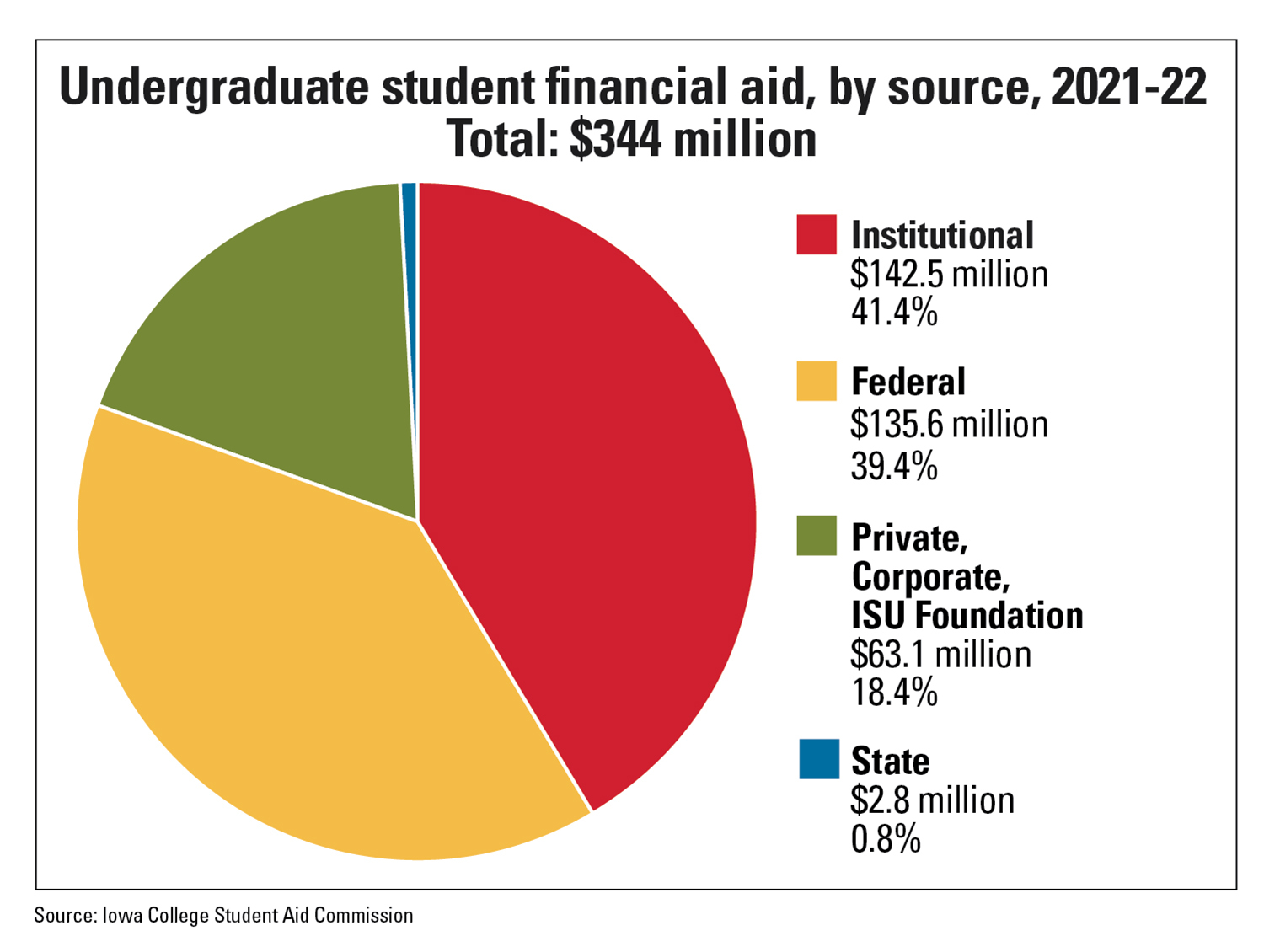
Graphic by Deb Berger. Larger image.
So two local resources have been pressed to make up more of the gap between cost and family resources, Johnson said.
Iowa State is the largest source of scholarships and grants for its undergraduates. From 2020-21 to 2021-22, university grants and scholarships (need- and merit-based combined) increased 5%, from $107.4 million to $112.8 million. During the same time, donor-funded awards secured by the ISU Foundation and the private/corporate scholarships students find on their own increased 2.5%, from nearly $29.9 million to $30.6 million last year.
University funding for campus employment also outpaces federal work study, last year $25 million to $1.8 million.
Johnson called the local aid "the only lever we have."
"Some of our families have great financial need, and as our state's land-grant university, we want to serve them," she said. "But we also need some leverage to recruit students to Iowa State, including those with the expectation their efforts during high school will be rewarded with merit consideration as they're applying to colleges."
Changes to FAFSA could shake up awards
This fall, parents who fill out the FAFSA form for the 2024-25 academic year will notice a big change in its length, from 108 questions to 36. The U.S. Department of Education will retrieve needed data from the Internal Revenue Service for tax filers. Driven by former U.S. Sen. Lamar Alexander and signed into law in December 2020, the shorter form is intended to be less intimidating to the lower income families it's supposed to help. Changes to its calculations should result in more students qualifying for aid. Other key changes to the form:
- Each student receives their own Student Aid Index (SAI), eliminating the Expected Family Contribution. Like the EFC, a higher SAI would result in less financial aid. An SAI still assumes a family contribution to the student's education cost, but as is the case now, some families choose to not contribute.
- Number of college students in the family isn't a factor, and there's no benefit to having children with overlapping college years.
- Filers must provide the net worth of their small business or family farm, absent from the form for several decades -- thus, making it difficult to calculate the impact on aid eligibility. Johnson said she and her regent colleagues are seeking assistance from public and private ag-focused organizations to understand the impact on student financial aid.
- For students with divorced parents, the parent who provides a majority of financial support is the filer.
- Students don't have to register for the Selective Service to complete the form.
"I'm really hopeful the shift to the SAI will be kinder to our middle income families," Johnson said.
Meghan Oster, research division lead at the state student aid agency Iowa College Aid, said her team calculated SAIs for Iowa residents attending a regent university from past years' data to anticipate changes and trends. She told the regents student SAIs generally will be lower than their EFC, meaning their eligibility for need-based aid would be higher. She said she expects more middle-income FAFSA filers will be eligible for Pell grants.
Johnson said raising the Pell grant maximum also would alleviate some of the pressure on institutional aid. President Joe Biden has proposed raising the maximum Pell grant award to $13,000 by 2029, and Congress approved an increase for 2023-24, to $7,395.
Debt at graduation
For more than a decade, the financial aid staff, through its office of student financial success, has promoted financial aid education for students -- especially regarding student loans -- with the goal of reducing student debt at graduation. That effort has seen results. Last year, 43% of students graduated without any debt. Debt among resident students has dropped to just over $25,000, while debt among nonresident students graduating with debt has risen the last few years, to $35,053. Overall student debt dropped from above $30,000 to $29,454 last year.
Johnson noted that for all students, debt is a combination of cost of attendance, family circumstances and personal choices.
"We strive to make an Iowa State education affordable for all students and provide as many options as possible to mitigate debt for all of our students," she said.
"Bringing graduation debt levels down is a years-long commitment. It's not something you can turn on a dime," she added.
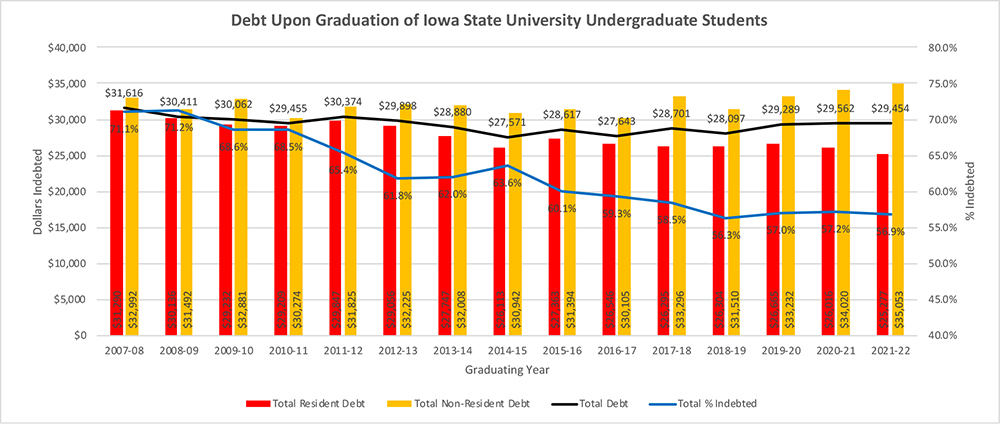
Source: ISU office of student financial aid. Larger image.
Top Hat will transition to enterprise solution
Instructors who use Top Hat, or those looking to try the learning app in Canvas, will have greater incentive beginning with summer session. The university has a new enterprise agreement with the app's creator, eliminating the need for student subscriptions.
"Students will no longer need to purchase a Top Hat subscription as part of their course materials," said Gretchen Anderson, Center for Excellence in Learning and Teaching (CELT) instructional technology specialist. "As we moved through the pandemic and saw the shift in learning technology -- synchronously and asynchronously -- Top Hat expanded its services to meet those needs."
About 21,000 students and more than 300 instructors are using Top Hat this semester. Faculty are encouraged to see how some of the new features can enhance their courses without having to consider the financial barrier to students, Anderson said. Currently, students must purchase a semester ($21) license for Top Hat, which can be used in all their courses.
"We're always looking for ways to reduce student expenses on technology solutions, and this was an opportunity to do that and lower the total spend," said chief technology officer Michael Lohrbach. "We often get questions from students about better standardizing tools for student engagement and interaction and we were able to accomplish it."
Lohrbach said information technology services tries to offer more technology options to campus. For example, Qualtrics -- a survey software -- also went from an individual to enterprise solution on campus several years ago.
Top Hat staff continue to be responsive to faculty needs since ISU began using it in 2016, Anderson said. In addition to increasing the classroom tools, instructors can partner with Top Hat to create textbooks for their courses available to students through immediate access, and incorporate existing question banks for a variety of assessments, including in STEM courses.
How does Top Hat work?
Top Hat is a collaboration tool between instructors and students and works both in the classroom and online. It offers live polling, discussion topics and quizzes, and instructors can assign group work to be submitted online. Collecting information in real time allows faculty to see how students understand lessons and students to provide feedback. It also helps instructors discuss sensitive material in a more comfortable way for students.
"Instructors can create and assign dynamic content ahead of class so the student comes prepared and ready to engage," Anderson said.
Need help?
As instructors consider Top Hat for their courses, CELT will offer several events for them to interact with Top Hat representatives and ISU faculty who use it, starting with a series of workshops and discussions on April 5-6. Webinars will follow throughout the summer.
CELT instructional technology specialist Misty Zimmerman said the workshops will have content for first-time users all the way to experienced faculty. The workshops will also focus on possible Top Hat uses in graduate courses and increasing engagement in courses with high D, F and withdrawal rates.
Faculty and graduate students interested in learning more can attend the ISU Online Learning Community event Friday, March 10. It will preview topics to be covered in April. Instructors can get help with instructional design and technical questions directly from Top Hat's support center. Faculty with questions about integrating Top Hat into their courses can email celt-help@iastate.edu.
Council elects executive officers for 2023-24
At the March 2 meeting, Professional and Scientific (P&S) Council members cast their votes for the 2023-24 elected council officer positions. The selected individuals will begin their terms on July 1.
-
Patrick Wall, extension and outreach – president
-
Jason Follett, software engineering – president-elect
-
Jamie Sass, college of business – past president
-
Sarah Larkin, graduate college – vice president, university community relations
-
Marlene Jacks, college of engineering – vice president, equity and inclusion
-
Steve Couchman, university human resources – vice president, university planning and budget
-
Suzanne Ankerstjerne, geological and atmospheric sciences – secretary-treasurer
Larkin and Jacks were reelected to their roles, while Couchman, Ankerstjerne and Follett are new to their positions.
General business
-
President Jamie Sass thanked the P&S Council Professional Development Conference planning committee for its work on a successful 2023 event with over 300 participants. Sass said the committee will need a new chair next year as longtime chair Tera Lawson steps down.
-
Larkin reminded council members of upcoming dates for meet-and-greet events, listed below. For more information about council events, visit the P&S Council website.
-
March 24 (3-5 p.m.), CyBowl and Billiards, Memorial Union
-
April 12 (4:10-5 p.m.), Brew lab tour, Food Sciences Building
-
May (Time TBA), steam tunnel tour
-
Policies and procedures committee chair Paul Easker discussed the proposed policy for employment of out-of-state and out-of-country (international) residents and encouraged those interested to submit comments and questions ahead of the March 10 deadline.
College-by-college pitch off results
New idea
College of Veterinary Medicine
- First place: Tiare Takaesu
- Second place: Tatiana Garcia-Marrero
Ivy College of Business
- First place: Aidan Bostwick
- Second place: Jazmin Lambertson
College of Agriculture and Life Sciences
- First place: Allison Dagli
- Second place: Taylor Mayhue
College of Design
- First place: Lydia Dayton
- Second place: Cale Murray
College of Engineering
- First place: Skyler Burke and Paige Wogahn
- Second place: Dakota Belling and Eugene Meyer
College of Liberal Arts and Sciences
- First place: Sidney Messerly
- Second place: Cassandra Cook
College of Human Sciences
- First place: Kaylee Brown
- Second place: Mia Nichols
Existing business
Ivy College of Business
- First place: Zackry Brannen
- Second place: Tristan Loving and Santosh Ramakrishnan
College of Agriculture and Life Sciences
- First place: Cameryn Schafer
- Second place: Arilyn Tegtmeier-Oatman
College of Design
- First place: Gavin Harms
- Second place: Grant Stotts
College of Engineering
- First place: Tyler Heintz
- Second place: Jack Evans
College of Liberal Arts and Sciences
- First place: Pradyumna Dahal and Henry Shires
- Second place: Kaleb Nichols
College of Human Sciences
- First place: Andrew Bergerson
- Second place: Irma Guzman
No College of Veterinary Medicine students competed in this category this spring.
Spring into break
While central Iowa may not be the most popular spring break destination, there is plenty to do for those in the area during the university's spring break next week.
Cyclone athletics
-
The Cyclone softball team has two doubleheaders with free admission at the Cyclone Sports Complex, the first against Brigham Young University on Friday, March 17 (1 p.m. and 3:30 p.m.) and the second versus University of Nebraska, Omaha, on Sunday, March 19 (1 p.m. and 3:30 p.m.).
March 14 update: The doubleheader with BYU is canceled due to forecasted low temperatures for Ames. -
The Cyclone tennis team will take on Kansas State on Sunday, March 12 (11 a.m., Forker tennis courts). Admission is free. In the case of inclement weather, the match will be played at Life Time Fitness (11911 Hickman Rd., Urbandale).
-
The first and second rounds of the NCAA Division I men's basketball tournament will be played at the Wells Fargo Arena in Des Moines on Thursday, March 16, and Saturday, March 18. Visit the Iowa Events Center website for game times and ticket information. Team matchups will be announced on March 12, Selection Sunday, for men's and women's basketball -- both Iowa State teams are expected to get a bid in the tournament.
Volunteer at SHOP
The SHOP food pantry, 1306 Beyer, needs faculty and staff volunteers over spring break to keep the pantry open to students, and a few volunteer slots still are open. Choose a time on the signup form and visit the website to learn more about the organization.
SHOP's service hours are:
- Monday, 1-6 p.m.
- Tuesday, 5-8 p.m. (9-11 a.m. food stocking)
- Wednesday, 2-7 p.m.
- Friday, 11 a.m.-4 p.m.
Reiman Gardens
Calling all green thumbs -- check out these activities and more on the Reiman Gardens website.
- March 14, Floral Design (6-7 p.m. $50 for members, $66 for general public): Create a succulent arrangement with instructor and State Fair master floral judge Sandy Gossman.
- March 18, Great Gardening (9-11 a.m., $20 for members, $27 for general public): Learn how to start plants from seeds and cuttings with production and glasshouse horticulturist Jessie Liebenguth.
CyBowl and Billiards
Located on the ground floor of the Memorial Union, CyBowl and Billiards will be open noon-7 p.m. over spring break.
University Museums
Though the Farm House Museum and Christian Petersen Art Museum are closed during spring break, the Brunnier Art Museum (Scheman Building second floor, 1805 Center Drive) will be open Tuesday-Friday (10 a.m.-4 p.m.) and Saturday and Sunday (1 p.m.-4 p.m.). Admission is free, and there are three exhibitions.
-
Joyce J. Scott: Messages: Brunnier Art Museum curator Adrienne Gennett will tour the exhibition and explore the storytelling in Scott's beadwork and traditions of beadwork around the world on Sunday, March 12 (2-3 p.m., free admission)
-
Telling Tales: Exploring Narrative Art in the Permanent Collection: Narrative art uses visual representations to tell stories without words.
-
Reflections of Iowa: The History of Iowa Questers through Glass: The Iowa Quester Glass Collection showcases American glass from 1840 to 1950.
Ames Public Library book sale
The 2023 Ames Public Library Book Sale is March 9-12 (515 Douglas Ave.). All items are free on March 12.
- Thursday, March 9 (5:30 to 8:30 p.m.): $2 admission
- Friday, March 10 (9 a.m.-6 p.m.): Free admission
- Saturday, March 11 (9 a..m-6 p.m.): Free admission
- Sunday, March 12 (12-5 p.m.): $1 admission
